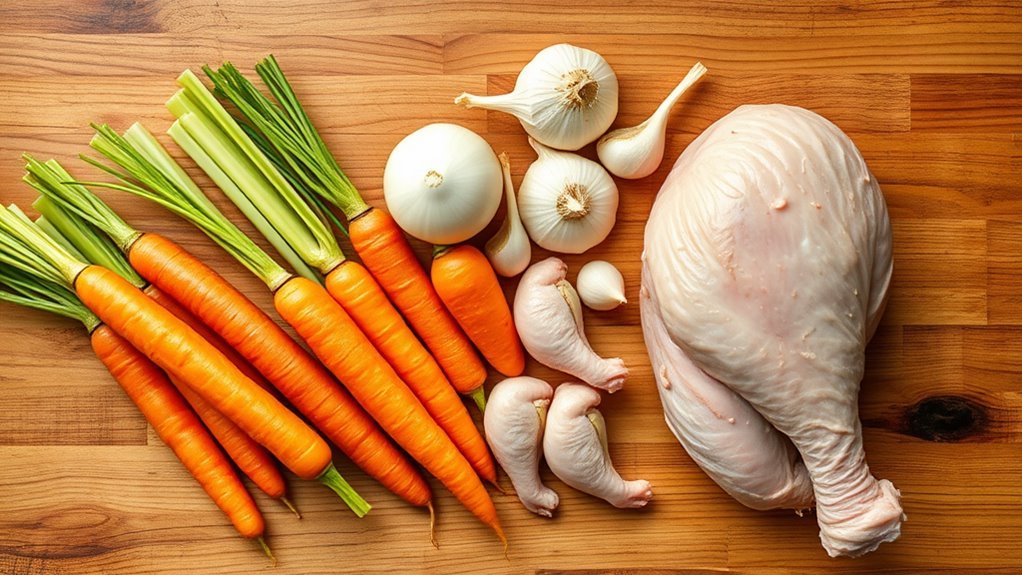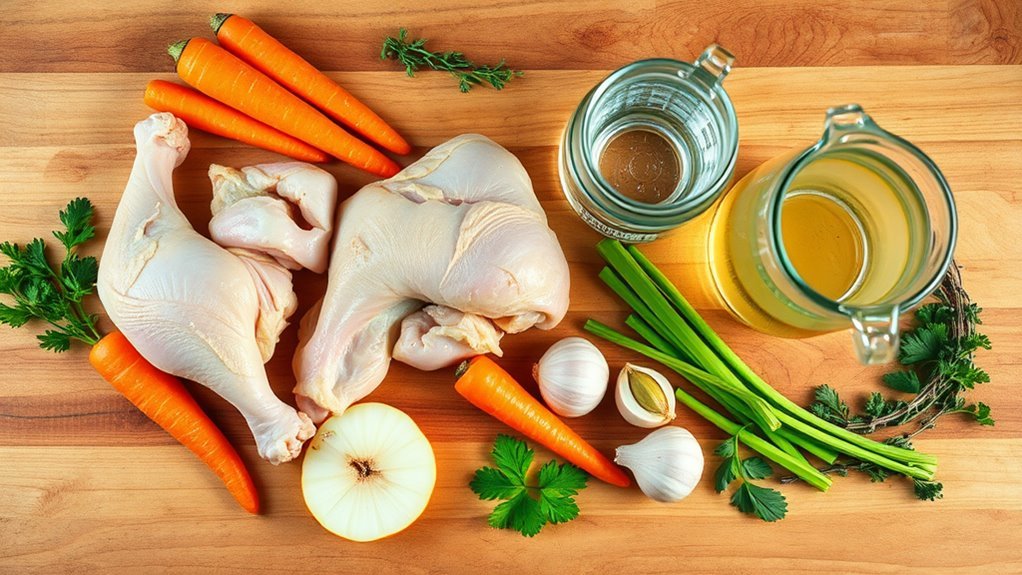Alright, let's get down to brass tacks, shall we? Making a homemade chicken broth is one of those fundamental kitchen skills that every cook should have up their sleeve. It's a bit like creating a warm hug in a bowl. Seriously, once you taste that rich, comforting flavor from a broth made from scratch, you'll understand why it's worth your time.
You don't need a fancy recipe or complicated techniques here—just bones, a few veggies, and a little bit of love will do the trick. We're talking carrots, onions, celery—the usual suspects—along with whatever chicken parts you might have lying around. And trust me, as you simmer these ingredients together, your kitchen will fill with a heavenly aroma that just might make you rethink any plans for takeout tonight.
So grab your trusty pot and let's dive into this simple process. We're turning humble ingredients into liquid gold—no store-bought stuff can hold a candle to the richness you'll get from your own stovetop. Ready to make some broth that warms the soul? Let's get started!
Ingredients

To create a rich and flavorful homemade chicken broth, start by gathering the main ingredient options: 3 pounds of chicken wings, backs, necks, or carcasses. Alternatively, you can use a combination of 5 pounds of chicken bones with a turkey leg, ensuring to remove the skin and cut it into four pieces for the best flavor extraction. The broth's aromatic qualities are enhanced by including classic base vegetables like carrots, celery, onions, and garlic. These vegetables not only add depth to the broth but also contribute a subtle sweetness. Herbs also play a vital role; parsley, thyme, and bay leaves are recommended to lend an aromatic and fresh element to the broth.
Begin by placing the poultry ingredients and vegetables in a large stockpot before adding 3 to 6 quarts of water—enough to cover everything adequately. Throughout the simmering process, you may need to add more water to keep the ingredients submerged and to achieve the desired volume of broth. For seasoning, a sprinkle of salt and black pepper can be adjusted to taste, with about half a teaspoon of salt serving as a general guideline. While salt is optional, it enhances the flavors of the broth, balancing the natural sweetness of the vegetables and the earthiness of the herbs.
| Ingredient | Type | Amount |
|---|---|---|
| Chicken parts | Protein | 3 pounds |
| Chicken bones | Protein | 5 pounds |
| Turkey leg (skinless) | Protein | 1 (cut into 4 pieces) |
| Carrots | Vegetable | As needed (aromatic base) |
| Celery | Vegetable | As needed (aromatic base) |
| Onion | Vegetable | As needed (aromatic base) |
| Garlic | Vegetable | As needed (aromatic base) |
| Parsley | Herb | As needed (for aroma) |
| Thyme | Herb | As needed (for aroma) |
| Bay leaf | Herb | As needed (for aroma) |
| Water | Liquid | 3-6 quarts |
| Salt | Seasoning | 1/2 teaspoon (optional) |
| Black pepper | Seasoning | To taste (optional) |
Recipe

Recipe
Homemade chicken broth is a flavorful and versatile base for many dishes, offering both nourishing elements and a depth of flavor that elevates any meal. This recipe uses either chicken wings, backs, necks, or carcasses, or alternatively, a combination of chicken bones and a turkey leg to create a rich and savory broth.
Alongside these, essential vegetables such as carrots, celery, onion, and garlic contribute to a robust aromatic foundation. Aromatic herbs like parsley, thyme, and bay leaf further enhance the fragrance and color, infusing the broth with a complex yet delicate flavor profile.
The preparation involves slow simmering to extract maximum flavors; a process that fills your kitchen with a comforting aroma. Simmering on the stovetop for 3-6 hours or using an electric pressure cooker for 1 hour allows the ingredients to release their essence without overwhelming the senses.
Once cooked and cooled, the broth is strained through a fine mesh strainer or cheesecloth to remove the solids, resulting in a clear and pure liquid. This homemade broth can then be used directly or stored for future culinary endeavors, acting as the perfect homemade base for soups, stews, or sauces.
Cooking Instructions:
Begin by gathering 3 pounds of chicken wings, backs, necks, or carcasses, or alternatively, use 5 pounds of chicken bones along with a turkey leg cut into four pieces, without skin.
Place these in a large stockpot or pressure cooker along with 2 chopped carrots, 2 ribs of celery chopped, 1 large onion quartered, and 1 head of garlic halved. Add a handful of fresh parsley, 2 sprigs of thyme, and 1 bay leaf for a fragrant base.
Pour enough cold water to cover the contents by about 1 inch. For stovetop preparation, bring the mixture to a gentle boil over medium-high heat, then reduce to a simmer for 3-6 hours, occasionally skimming off foam or impurities.
If using a pressure cooker, secure the lid, bring to pressure, and cook for 1 hour. After cooking, carefully release pressure if using a cooker, and cool slightly before straining through a fine mesh strainer or cheesecloth into a clean container.
Discard the solids and let the broth cool completely, skimming fat off the top once it's cooled.
Extra Tips:
For a clearer broth, avoid stirring the mixture during cooking, as this can cause the solids to break down further and cloud the broth.
Additionally, use cold water at the start, which promotes better extraction of flavors from the bones and vegetables. If you prefer a more concentrated flavor, simmer for the longer end of the recommended time or use less water.
Always taste the broth before using it in recipes, adjusting for salt and seasoning as necessary based on your intended dish. The broth can be frozen in airtight containers or ice cube trays for easy portioning and storage, providing a convenient way to add depth and flavor to your meals at any time.
Cooking Tips

Ever wonder how to achieve the richest flavor in your homemade chicken broth? Here's the secret sauce, so to speak. Begin with bone-in, skin-on chicken parts; they're magic, releasing collagen and fat into your broth.
For an extra burst of flavor, roast those chicken bones for about 30 minutes before they meet the large stock pot. It's like giving your broth a deep, savory hug it won't forget.
Now, to get all those flavors singing in harmony, let your broth simmer on low for about 3-6 hours. If you're in a hurry, no worries—just cook on high pressure in an electric pressure cooker for one hour. It's like a flavor fast-forward button.
But remember, during the initial boiling phase, you'll want to skim the foam off the top. This step helps guarantee your chicken broth stays clean and clear.
Once the magic has happened, it's time to strain the broth using a fine-mesh strainer. This gets rid of all the solids, leaving you with a smooth, silky homemade chicken broth. With these tips, you're all set to create a broth that's not just good—it's love in liquid form.
History

While we might think of chicken broth as a simple kitchen staple, its roots stretch back through centuries of culinary history. The practice of simmering bones to create a flavorful broth dates back to ancient times.
Imagine this: mysterious concoctions bubbling in ancient Chinese, Greek, and Roman kitchens, nourishing souls then just as they do us now. Isn't it fascinating how a simple recipe can connect us across millennia?
During medieval times in Europe, broth became a staple, often crafted from scraps of meat or chicken and a hodgepodge of vegetables to form a filling, warming meal. It was a time when resourcefulness ruled the kitchen, and every morsel was utilized.
Fast forward to the evolution in French cuisine, where the 17th and 18th centuries saw distinctions arise between broth and stock—laying the groundwork for sumptuous sauces and soups that followed.
Conclusion
And there you have it—your very own homemade chicken broth, simmered to perfection. There's something incredibly comforting about making your own broth; it's like infusing your kitchen with warmth and flavor. Just think about it: all those fresh herbs and veggies mingling together, creating a nourishing elixir that can elevate any dish from decent to delightful. Don't forget to ladle some into jars for the freezer! Future you will appreciate having a batch on hand when inspiration strikes for a hearty soup or a savory risotto. So roll up your sleeves and enjoy the process—good food takes time, and the results are worth every minute. Happy cooking!

